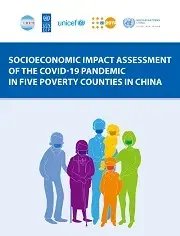According to the Sustainable Development Report 2020, by late 2019, the world was not on track to achieve the Sustainable Development Goals (SDGs) and COVID-19 has brought even more challenges in SDGs attainment.
While China has lifted 750 million out of poverty over the last four decades and it is set to eliminate absolute rural poverty by 2020, more efforts are still needed in preventing those people sliding back to poverty. As of the end of 2019, about 5.51 million rural people in the country remained in poverty, while many others were no longer classified as poor, but are still close to the poverty line. These two groups are especially vulnerable during times of crisis, such as COVID-19, economically, socially and in terms of health.
To understand and respond to the effects of COVID-19 on these and other groups at risk, the United Nation Development Program and the China International Center for Economic and Technical Exchanges, jointly assessed the socioeconomic impact of COVID-19 on five officially designated poverty-stricken counties in China, with the support of Office of the Resident Coordinator, the United Nations Children’s Fund and the United Nations Population Fund.
The aim was to gather information on how the pandemic has affected impoverished regions and, in particular, vulnerable groups in those areas. The first-hand data and information collected through this assessment are being used to inform the design of UN programmes in the immediate future and provide evidence for local governments in how best to address the socioeconomic effects of the pandemic on their populations. The impact assessment was undertaken in June 2020, after COVID-19 was contained in China, making fieldwork possible. The regions selected to carry out the assessment in were five national and provincial-level poverty-affected counties: Chengbu County in Hunan Province, Zhouqu County in Gansu Province, Neixiang County in Henan Province, Yilong County in Sichuan Province, and Zhangwan District, Shiyan City, Hubei Province.
Using household survey data and findings from discussions with local governments at different administrative levels, this joint study investigated the impact of COVID-19 on these populations and the challenges as they seek to recover, with a focus on children, women and older people. This assessment also provides evidence on policymaking, pandemic response and post-pandemic livelihood recovery, tailored to these and other groups.





